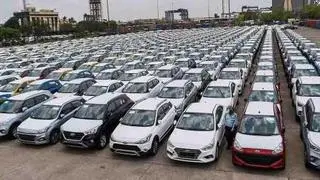Consistent efforts to supply coal to the power sector on a priority basis have started paying off.
But the non-power sector — such as cement and steel — is suffering from the low availability of domestic coal and spike in international prices, leading to an impact on the bottomline. And, as growth rebounds, there may not be any immediate solution to the crisis.
Global prices
International coal prices were ruling strong from the beginning of this year and touched a multi-year high in early March. Though prices softened after that, the recent commodity price spike saw coal prices firming up sharply.
The 4,200 and 3,800 calorific value Indonesian thermal coal, which are mostly used in India, are now ruling over $48 a tonne and $38 a tonne respectively, marginally below the March peak.
The price of American coal, which is now replacing part of the cement industry demand for petroleum coke, increased by $2 to $109 a tonne in barely a week.
The spike in prices impacted demand for imported fuel by the steel and cement sector, which were at the forefront of the import rush last year when the coal crisis hit India.
During April-May this year, India imported 26.5 million tonnes of coal against 28.2 mt during the same period last year. In comparison, imports were up from 149 mt to 151 mt last year.
The impact is not uniform. In the steel sector, large integrated players who use multiple options for steel making, depending on cost dynamics, are less affected. The GST rollout benefited them. They are now reaping the maximum benefits of the recent growth momentum and are on a consolidation mode.
But scores of secondary steel producers using thermal coal for energy to make sponge iron (using DRI route), who were already in trouble, are doubly hit by the coal crisis. Secondary steel production was down by 6.2 per cent in April-December 2017 as against an overall robust growth in steel.
According to Subhasri Chaudhury, Secretary General of the Coal Consumers’ Association of India, nearly 3,000 rakes of contracted supplies are pending to non-power consumers. “Western Coalfields stopped supplies to non-power customers. Mahanadi Coalfields didn’t supply after October,” she said.
Western and Mahanadi are Coal India subsidiaries. “Things are expected to be tough for the secondary steel makers in the days to come,” said an industry insider who did not want to be named.
Meanwhile, the cement sector reports shrinking margin due to a rise in fuel cost. Though witnessing a demand pull, cement makers do not enjoy a spiral in product prices due to over-capacity.
In the past, cement makers found a good alternative in petroleum coke to replace demand for either imported or domestic coal. But recent restrictions on pet coke prices impacted this plan.
Among the positives, a cement maker reports improvement in wagon availability to transport fuel from ports to the plants, mostly in the hinterland. “The waiting time for getting supply of rakes at Gangavaram, one of the busiest ports on the East Coast, recently came down from five-six weeks to three weeks,” a top cement company official said.
In the power generation sector, imported coal based units are surely impacted. But the overall supply position has improved between April and June, riding on a 12.3 per cent rise in total supplies (offtake) to 136 mt during the quarter so far. Production is also up 15 per cent.
Emphasis on power
Loading from CIL sidings are ruling at 241 rakes a day, up from 219 rakes last year. The emphasis on supplies to the power sector is evident from the fact that of the 285 rakes loaded a day (including own sidings and railway sidings), 261 are directed to the power sector. As a definite impact, the number of power stations having critical coal stock is down from 31 in April to barely 12 on June 18.
“With the onset of the monsoon which should enhance supplies of hydel and reduce demand for power; the availability of fuel in thermal power should improve in the coming months. But supplies to other consumer may continue to suffer,” a source said.








Comments
Comments have to be in English, and in full sentences. They cannot be abusive or personal. Please abide by our community guidelines for posting your comments.
We have migrated to a new commenting platform. If you are already a registered user of TheHindu Businessline and logged in, you may continue to engage with our articles. If you do not have an account please register and login to post comments. Users can access their older comments by logging into their accounts on Vuukle.